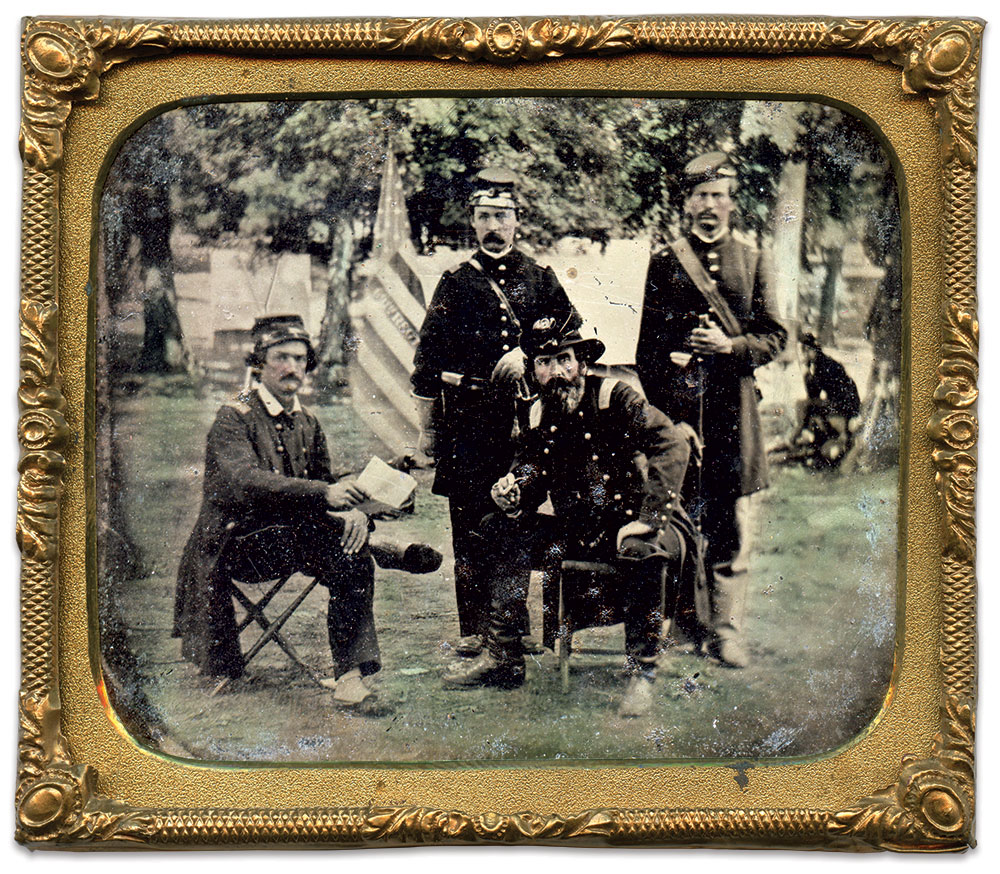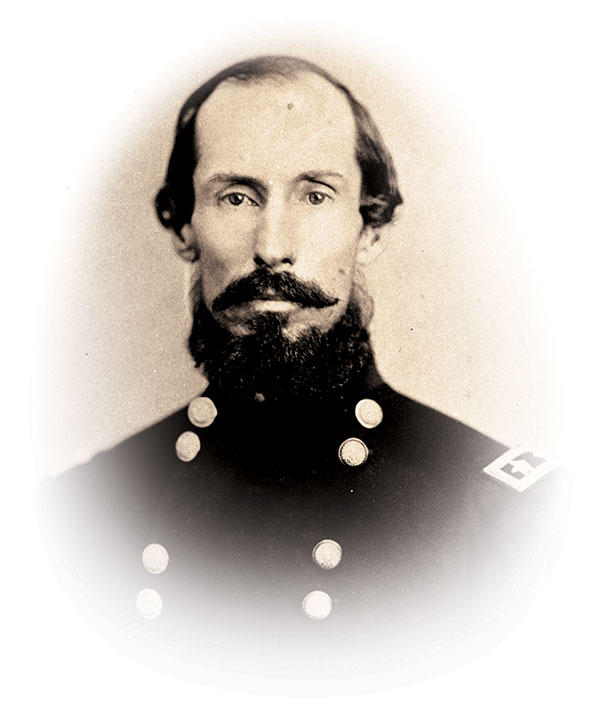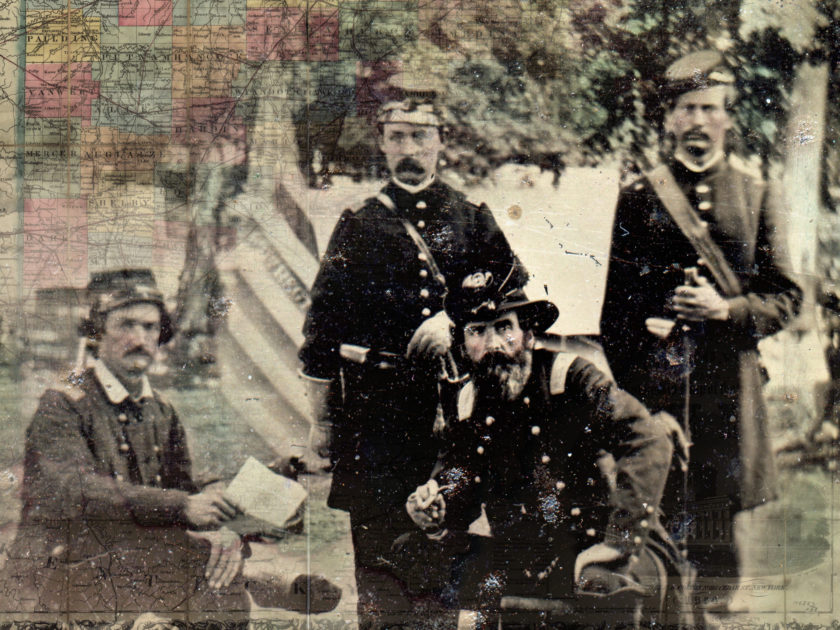By David Holcomb
When the time came for Ohio Gov. William Dennison to raise a regiment from the Cincinnati area in the fall of 1861, he knew just the man for the job: Lewis David Campbell. A former three-term Congressman who had represented southwest Ohio, Campbell left office in 1854 with a reputation as an ardent abolitionist fiercely opposed to the expansion of slavery.

During his final year in the House, Campbell led a filibuster against the Kansas-Nebraska Act that enraged Rep. Henry A. Edmundson of Virginia, a pro-slavery Democrat. Instead of the usual exchange of insults on the House floor, weapons were drawn and Edmundson had to be physically restrained from attacking Campbell. Order was restored only after the sergeant at arms arrested the Virginian and adjourned the House.
Gov. Dennison appointed Campbell as a colonel of U.S. volunteers and tasked him with the organization of the 69th Ohio Infantry. Campbell promptly raised the regiment for a 3-year enlistment. Barely 10 months later, on Aug. 9, 1862, Campbell quit due to ill health. He made no mention of pending charges against him of drunkenness and conduct unbecoming an officer and gentleman. Rather than face a courts martial, he claimed ill health and resigned —a way out taken by many officers to protect their reputations.
Campbell’s battle with the bottle was common knowledge in the regiment. One soldier, Sgt. John S. Scott of Company A, wrote to his mother from Murfreesboro, Tenn., on June 9, 1862, “I am going to write something which I hoped never be written. Col. Campbell is once more a hard drinking man and I don’t think there is a dozen men who would not like to see him hung right up. We have no confidence in him whatever. He gives ridiculous orders and frequently draws his pistol to shoot someone.”
The man who succeeded Campbell, William Biddle Cassilly, the regiment’s lieutenant colonel, promised a fresh start for Sgt. Scott and his comrades. Born in Pittsburgh and raised in Cincinnati, Cassilly possessed a respectable military resume. He had previously served as a lieutenant in the 10th Ohio Infantry for a 3-month stint in 1861. He reenlisted, transferred to the Missouri Infantry, and received a commission as lieutenant colonel with the Benton Cadets, which served as the bodyguard of one of America’s highest profile soldiers, Maj. Gen. John C. Frémont. In January 1862, Cassilly joined the 69th. He served as military governor of Franklin, Tenn., just prior to his advancement to colonel.

This tintype may capture the transfer of command. Outgoing Col. Campbell sits on the left, wearing camp slippers and holding a document. The officer seated next to him, holding a pipe and wearing a dress hat with the number 69 in the center of the horn insignia, is likely incoming Col. Cassilly, of whom no corroborating portraits are yet known. Cassilly’s front and center location, leaning toward Campbell, suggests that the portrait was made at his behest. The two subordinate officers behind Cassilly are not exactly known. A review of officers present for duty on August 9, the date of Campbell’s resignation, suggests that the man on the left is the regiment’s adjutant, 1st Lt. Joseph W. Boynton or Asst. Surgeon Moses Haynes. The man on the right, wearing an officer of the day sash, resembles 1st Lt. and Quartermaster Frederick B. Landis. The national colors of the regiment displayed in the background complete this tableau of the command structure of the 69th.
About five months later, the 69th participated in its first major engagement at the 2-day Battle of Stones River. Early in the action, Col. Timothy R. Stanley, who led the brigade to which the regiment belonged, discovered Cassilly “so drunk as to be unfitted to command, and I ordered him to the rear in arrest.” Adding to the regiment’s senior leadership woes, Lt. Col. George F. Elliott hung back behind the front lines with a detachment of men.
The rank and file, according to one report, was “much mortified at the conduct of their Colonel and Lieutenant Colonel during the thickest of the fight. The former was stupidly, beastly drunk, and the latter was absent as usual.”
“The regiment is a good one, and only needed a leader on the first day to have taken a more active part in that engagement.”
Command fell to Maj. Eli J. Hickcox, who soon left the field with a concussion from the effects of the shell that unhorsed him. Leaderless, the lines and movements of the 69th faltered and floundered. Aides to Col. Stanley discovered the men scattered, rallied them, and placed the senior captain in charge.
About this time, Cassilly returned to the fight. He and his men participated in a brilliant and desperate charge across Stones River that drove back Confederates belonging to Maj. Gen. John C. Breckenridge’s Corps. Cassilly suffered a gunshot in the arm, but his battlefield heroics came too late to save his colonelcy. Stanley dismissed him from the service with a stern rebuke: “A man who will come to the field of battle, having the lives of so many in his keeping, in such a situation, no matter what his social position, is totally unfit for any command.”
The stain left by Cassilly’s conduct did not taint the men, who fought well despite the lack of consistent leadership. Stanley observed, “The regiment is a good one, and only needed a leader on the first day to have taken a more active part in that engagement.”

The regiment’s third colonel, Marshall Frank Moore, proved an able commander. A native New Yorker and graduate of Yale, he ended the war as a brevet major general and went on to serve a 2-year stint as governor of Washington Territory.
The 69th went on to fight in operations against Atlanta, Maj. Gen. Sherman’s March to the Sea, and the Carolinas Campaign. The survivors mustered out of the army in July 1865.
Assuming the identities of the four men in this photograph are correct, only one of them was present for duty at the war’s end—officer of the day, 1st Lt. Landis. 1st Lt. Boynton died of wounds received at Stones River.
Boynton’s remains were returned to Butler County, Ohio, for burial. The man who led the funeral procession from the church to nearby Greenwood Cemetery was former Col. Campbell, whose presence suggests his reputation as an upstanding citizen remained intact, despite his issue with alcohol.
After Campbell’s death two decades later in 1882, newspapers across the nation noted his political career—but barely mentioned his service in the Union army. When Cassilly passed away six years later, his death received scant notice.
References: Morrison, Slavery and the American West: The Eclipse of Manifest Destiny and the Coming of the Civil War; Widmer, “Lincoln Declares War,” New York Times Disunion, April 14, 2011; Frazier, The American Spirit, Vol. 1, “Lincoln Answers Greeley’s Prayer” (1862); Voices of America, Abraham Lincoln On Slavery and the Preservation of the Union; Hunt, Colonels in Blue: Michigan, Ohio and West Virginia; John S. Scott to his mother, June 9, 1862. David B. Holcomb Collection; Rosecrans, Report on the Battle of Murfreesboro’, Tenn.; Official Roster of the Soldiers of the State of Ohio in the War of the Rebellion, 1861-1866, Vol. 5.
David Holcomb of Worthington, Ohio, has been collecting historic photography since the late 1970’s. He sold the bulk of his collection through Cowan’s Auctions in 1999 to raise funds for a commercial building, and did not acquire a single image for 12 years as he raised his kids and built his business. In 2012, he returned to collecting with a focus on the Civil War, the Old West and fine daguerreotypes.
SPREAD THE WORD: We encourage you to share this story on social media and elsewhere to educate and raise awareness. If you wish to use any image on this page for another purpose, please request permission.
LEARN MORE about Military Images, America’s only magazine dedicated to showcasing, interpreting and preserving Civil War portrait photography.
VISIT OUR STORE to subscribe, renew a subscription, and more.

